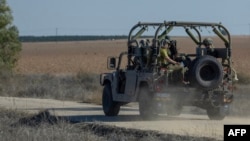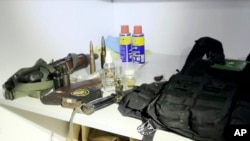Meanwhile, soldiers continued searching Shifa Hospital in the north, in a raid that began early Wednesday. They displayed guns they say were found hidden in one building, but have yet to release any evidence of the central Hamas command center that Israel has said is concealed beneath the complex. Hamas and staff at the hospital, Gaza's largest, deny the allegations.
Broadening operations to the south — where Israel already carries out daily air raids — threatens to worsen an already severe humanitarian crisis in the besieged territory. Over 1.5 million people have been internally displaced in Gaza, with most having fled to the south, where food, water and electricity are increasingly scarce.
It's not clear where else they could go, as Egypt refuses to allow a mass transfer onto its soil.
The war, now in its sixth week, was triggered by a wide-ranging Hamas attack into southern Israel on Oct. 7 in which the militants killed over 1,200 people, mostly civilians, and captured some 240 men, women and children. Israel responded with a weekslong air campaign and a ground invasion of northern Gaza, vowing to remove Hamas from power and crush its military capabilities.
More than 11,200 Palestinians have been killed, two-thirds of them women and minors, according to Palestinian health authorities. Another 2,700 have been reported missing, with most believed to be buried under the rubble. The official count does not differentiate between civilian and militant deaths, and Israel says it has killed thousands of militants.
The war has inflamed tensions elsewhere. On Thursday, gunmen shot and wounded four people at a checkpoint on the main road linking Jerusalem to Israeli settlements in the occupied West Bank. Police said three attackers were killed and a search for others was underway.
Some Guns, but So Far No Tunnels
Israeli troops stormed into Gaza’s largest hospital Wednesday, searching for traces of Hamas inside and beneath the facility, where newborns and hundreds of other patients have suffered for days without electricity and other basic necessities.
Troops searched the underground levels of the hospital on Thursday and detained technicians responsible for running its equipment, the Health Ministry in Hamas-run Gaza said in a statement.
The military said its soldiers were accompanied by medical teams bringing in incubators and other supplies.
After encircling Shifa for days, Israel faces pressure to prove its claim that Hamas used the patients, staff and civilians sheltering there to provide cover for its fighters. The allegation — which the U.S. has said it has intelligence to support — is part of Israel's broader accusation that Hamas uses Palestinians as human shields.
The military released video from inside Shifa showing three duffel bags it said it found hidden around an MRI lab, each containing an assault rifle, grenades and Hamas uniforms, as well as a closet that contained a number of assault rifles without ammunition clips. The Associated Press could not independently verify the Israeli claims that the weapons were found inside the hospital.
Hamas and Gaza health officials deny militants operate in Shifa — a hospital that employs some 1,500 people and has more than 500 beds. Palestinians and rights groups accuse Israel of recklessly endangering civilians.
Munir al-Boursh, a senior official with Gaza’s Health Ministry inside the hospital, said troops ransacked the basement and other buildings, and questioned and scanned the faces of patients, staff and people sheltering in the facility.
Israeli forces battled militants outside the hospital for days, but there were no reports of militants firing from inside Shifa, or of any fighting within the hospital after Israeli troops entered.
The Health Ministry said 40 patients, including three babies, have died since Shifa’s emergency generator ran out of fuel Saturday. There was no word on the condition of another 36 babies, who the ministry said earlier were at risk of dying.
Looking South
The leaflets, dropped in areas east of the southern town of Khan Younis, warned civilians to evacuate and said anyone in the vicinity of militants or their positions “is putting his life in danger.” Similar leaflets were dropped over northern Gaza for weeks ahead of the ground invasion.
Two reporters who live east of Khan Younis confirmed seeing the leaflets. Others shared images of the leaflets on social media. The military declined to comment.
Defense Minister Yoav Gallant said Wednesday the ground operation will eventually “include both the north and south. We will strike Hamas wherever it is.”
Even as Israel signals a wider offensive, it has yet to put forth a long-term plan, aside from saying it will maintain security control over Gaza indefinitely.
The U.S. has urged Israel not to reoccupy the territory, from which it withdrew soldiers and settlers in 2005, and supports the eventual creation of a Palestinian state including Gaza and the occupied West Bank — also the long-held aspiration of the Palestinians. Israel’s government was staunchly opposed to Palestinian statehood even before the war.
The military says it has largely consolidated its control of the north, including seizing and demolishing government buildings. Video released by the army Thursday showed soldiers moving between heavily damaged buildings through holes blown in their walls.
The military said it had blown up a residence belonging to Ismail Haniyeh, a senior Hamas leader based abroad. It was unclear if anyone was inside the building.
With most of Gaza’s 2.3 million people crowded into the territory’s south, residents say bread is scarce and supermarket shelves are bare. Families cook on wood fires for lack of fuel. Central electricity and running water have been out for weeks.
The worsening fuel shortage threatens to paralyze the delivery of humanitarian services and shut down mobile phone and internet service.
Israel allowed a small amount of fuel to enter Gaza on Wednesday, for the first time since the war began, so that the U.N. agency for Palestinian refugees could continue bringing limited supplies of aid.
The fuel cannot be used for hospitals or to desalinate water, and covers less than 10% of what the agency needs to sustain "lifesaving activities,” said Thomas White, the agency’s Gaza director.











Forum